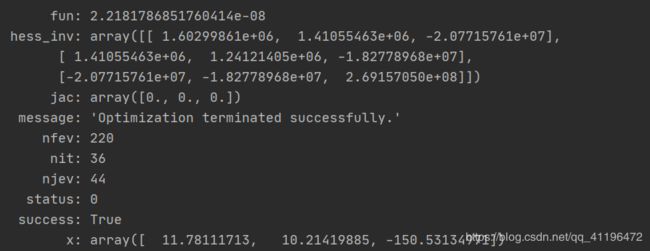二分类线性分类器python实现(一)
回归(Regression)与最小二乘法(Least squares)
用回归方法解决分类问题
Python代码
首先先生成数据集
import numpy as np
import matplotlib.pyplot as plt
import pickle
# 创建训练样本
N = 1000
# CLASS 1
x_c1 = np.random.randn(N, 2)
x_c1 = np.add(x_c1, [10, 10])
y_c1 = np.ones((N, 1), dtype=np.double)
# CLASS 2
x_c2 = np.random.randn(N, 2)
x_c2 = np.add(x_c2, [2, 5])
y_c2 = np.zeros((N, 1), dtype=np.double)
# 扩展权向量
ex_c1 = np.concatenate((x_c1, np.ones((N, 1))), 1)
ex_c2 = np.concatenate((x_c2, np.ones((N, 1))), 1)
# 生成数据
data_x = np.concatenate((ex_c1, ex_c2), 0)
data_y = np.concatenate((y_c1, y_c2), 0)
x1 = x_c1[:, 0].T
y1 = x_c1[:, 1].T
x2 = x_c2[:, 0].T
y2 = x_c2[:, 1].T
plt.plot(x1, y1, "bo", markersize=2)
plt.plot(x2, y2, "r*", markersize=2)
plt.show()
pickle_file = open('data_x.pkl', 'wb')
pickle.dump(data_x, pickle_file)
pickle_file.close()
pickle_file2 = open('data_y.pkl', 'wb')
pickle.dump(data_y, pickle_file2)
pickle_file2.close()
然后训练模型
from scipy.optimize import minimize
import numpy as np
import pickle
import matplotlib.pyplot as plt
pickle_file = open('data_x.pkl', 'rb')
data_x = pickle.load(pickle_file)
pickle_file.close()
pickle_file2 = open('data_y.pkl', 'rb')
data_y = pickle.load(pickle_file2)
pickle_file2.close()
N = np.size(data_y)
def fun(beta):
sum = 0
for j in range(N):
sum += (-data_y[j] * np.dot(beta, data_x[j].T) + np.log(1 + np.exp(np.dot(beta, data_x[j].T))))
return sum
def fun_jac(beta):
jac = np.zeros(np.shape(beta), dtype=np.double)
p1 = np.zeros(N, dtype=np.double)
for j in range(N):
p1[j] = np.exp(np.dot(beta, data_x[j].T)) / (1 + np.exp(np.dot(beta, data_x[j].T)))
jac = jac - (data_x[j]) * (data_y[j] - p1[j])
return jac
def fun_hess(beta):
hess = np.zeros((np.size(beta), np.size(beta)), dtype=np.double)
p1 = np.zeros(N, dtype=np.double)
for j in range(N):
p1[j] = np.exp(np.dot(beta, data_x[j].T)) / (1 + np.exp(np.dot(beta, data_x[j].T)))
hess += np.dot(data_x[j], data_x[j].T) * p1[j] * (1 - p1[j])
return hess
def callback(xk):
print(xk)
def line(beta, x):
return 1 / beta[1] * (- beta[0] * x - beta[2])
if __name__ == '__main__':
beta0 = np.array([[1., 1., 1.]])
res = minimize(fun, beta0, callback=callback, tol=1.e-14,
options={'disp': True})
print(res)
n = 100
# CLASS 1
x_c1_test = np.random.randn(n, 2)
x_c1_test = np.add(x_c1_test, [10, 10])
ex_c1_test = np.concatenate((x_c1_test, np.ones((n, 1))), 1) # 扩展权向量
# CLASS 2
x_c2_test = np.random.randn(n, 2)
x_c2_test = np.add(x_c2_test, [2, 5])
ex_c2_test = np.concatenate((x_c2_test, np.ones((n, 1))), 1) # 扩展权向量
data_x_test = np.concatenate((ex_c1_test, ex_c2_test), 0)
x1 = x_c1_test[:, 0].T
y1 = x_c1_test[:, 1].T
x2 = x_c2_test[:, 0].T
y2 = x_c2_test[:, 1].T
X = np.linspace(0, 10, 1000)
plt.plot(x1, y1, "b+", markersize=5)
plt.plot(x2, y2, "r+", markersize=5)
plt.plot(X, line(res.x, X), linestyle="-", color="black")
plt.show()
beta_x_hat = np.zeros(2 * n)
y_hat = np.zeros(2 * n)
for i in range(2 * n):
beta_x_hat[i] = np.dot(res.x, data_x_test[i].T)
y_hat[i] = np.exp(beta_x_hat[i]) / (1 + np.exp(beta_x_hat[i]))
print(y_hat)
测试数据
二元函数的图像如下:









